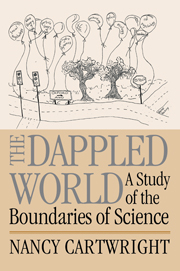Introduction
Published online by Cambridge University Press: 05 June 2012
Summary
This book supposes that, as appearances suggest, we live in a dappled world, a world rich in different things, with different natures, behaving in different ways. The laws that describe this world are a patchwork, not a pyramid. They do not take after the simple, elegant and abstract structure of a system of axioms and theorems. Rather they look like – and steadfastly stick to looking like – science as we know it: apportioned into disciplines, apparently arbitrarily grown up; governing different sets of properties at different levels of abstraction; pockets of great precision; large parcels of qualitative maxims resisting precise formulation; erratic overlaps; here and there, once in a while, corners that line up, but mostly ragged edges; and always the cover of law just loosely attached to the jumbled world of material things. For all we know, most of what occurs in nature occurs by hap, subject to no law at all. What happens is more like an outcome of negotiation between domains than the logical consequence of a system of order. The dappled world is what, for the most part, comes naturally: regimented behaviour results from good engineering.
I shall focus on physics and economics, for these are both disciplines with imperialist tendencies: they repeatedly aspire to account for almost everything, the first in the natural world, the second in the social. Since at least the time of the Mechanical Philosophy, physicists have been busy at work on a theory of everything.
Information
- Type
- Chapter
- Information
- The Dappled WorldA Study of the Boundaries of Science, pp. 1 - 20Publisher: Cambridge University PressPrint publication year: 1999
